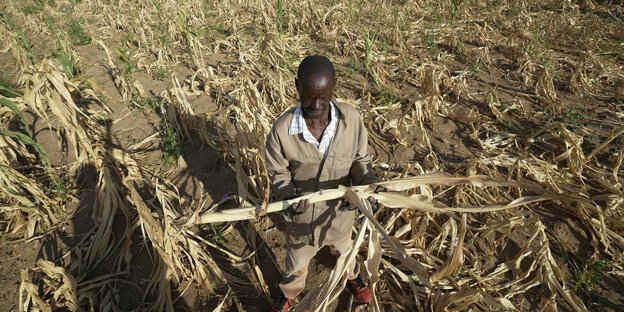After Zambia and Malawi, another southern African country is raising the alarm about extreme weather conditions due to climate change and the El Niño effect.

In the Mangwe district of southwestern Zimbabwe, a farmer inspects his withered corn field. Photo: Tsvangirayi Mukwazhi/AP/dpa-Bildfunk
HARARE/LUSAKA taz | Zimbabwe's President Emmerson Mnangagwa has declared a national emergency due to extreme drought. In a televised address Wednesday night, the president said four-fifths of the country had received too little rain for a normal harvest.
He called for international help and mobilization of the private sector to increase food imports. “According to preliminary surveys, Zimbabwe needs more than $2 billion to fund various measures we are considering as part of our national response,” Mnangagwa said.
With an expected cereal harvest of just under 870,000 tonnes this year, following the record harvests of 2023, an additional 680,000 tonnes would have to be purchased abroad to ensure the nutrition of the population. “Our top priority is to ensure that all Zimbabweans have food. “No Zimbabwean should go hungry or die of hunger.”
We are working on strategies to combat this and we want to mobilize all forces, the president continued. “There are already measures to encourage the participation of the private sector. “The fact that Zimbabwe now has to import grain on a large scale is a serious blow to an already difficult economic situation. Zimbabwe used to be a grain exporter.
Poor harvests cause prices to rise
The neighboring countries of Zambia and Malawi had already declared a drought emergency in February. The international food early warning system FEWSNET expects particularly poor harvests throughout the region in 2024 and, therefore, an increase in prices for the population and a fall in income.
Water is also increasingly scarce. This means that grazing conditions for livestock are deteriorating. Higher herd mortality rates are expected. This drives down sales prices for breeders, who therefore have less money to buy animal feed: a vicious circle.
Zambian Interior Minister Jacob Mwiimbu spoke of the worst drought in living memory. “The destruction caused by the current drought threatens food security, as well as water and energy supplies. We live in difficult times,” he stated. “The country is only just recovering from the cholera epidemic, which has devastated many communities and required the deployment of significant resources.” More than 700 people had died of cholera in Zambia.
UN: The worst drought in the region has been going on for 40 years
According to the UN, southern Africa is currently suffering its worst drought in 40 years. In any case, violent cyclones occur every year over the Indian Ocean, causing coastal flooding.
This year, hurricanes also caused damage in parts of Madagascar and Mozambique. All these weather conditions are accompanied by extreme heat. The global climate phenomenon El Niño is blamed. The region is suffering from above-average extreme weather conditions due to global climate change, international aid organization Oxfam warns. It estimates that 24 million people in Zimbabwe, Zambia, Malawi and Mozambique are at risk of hunger this year.